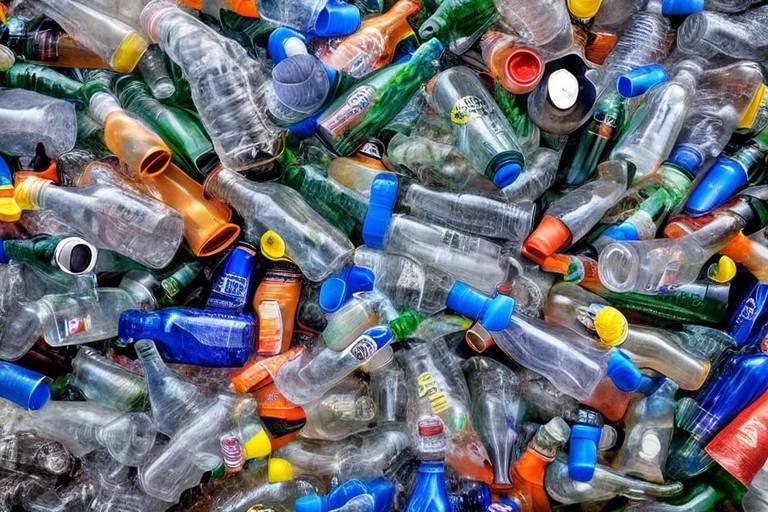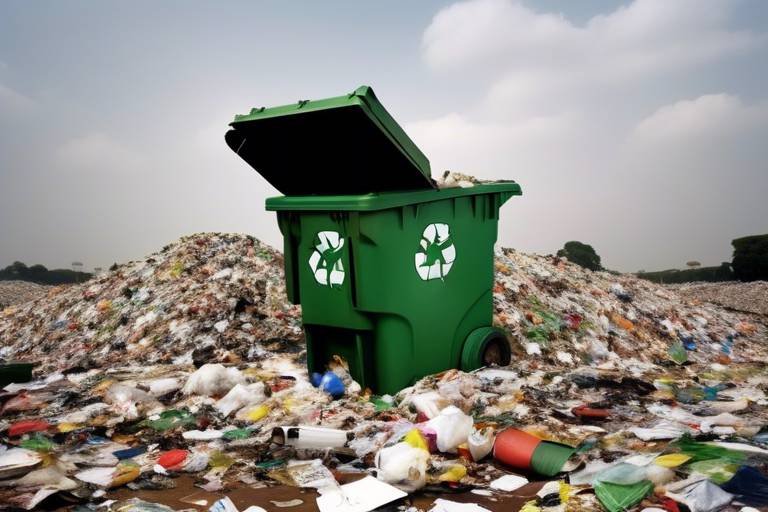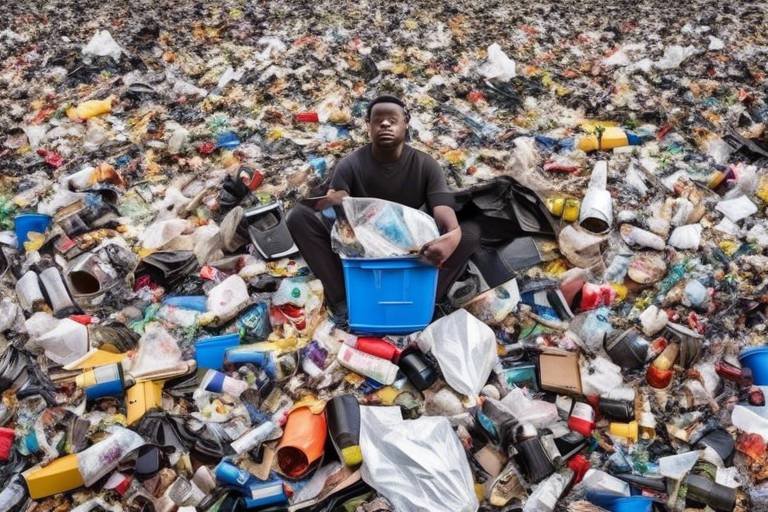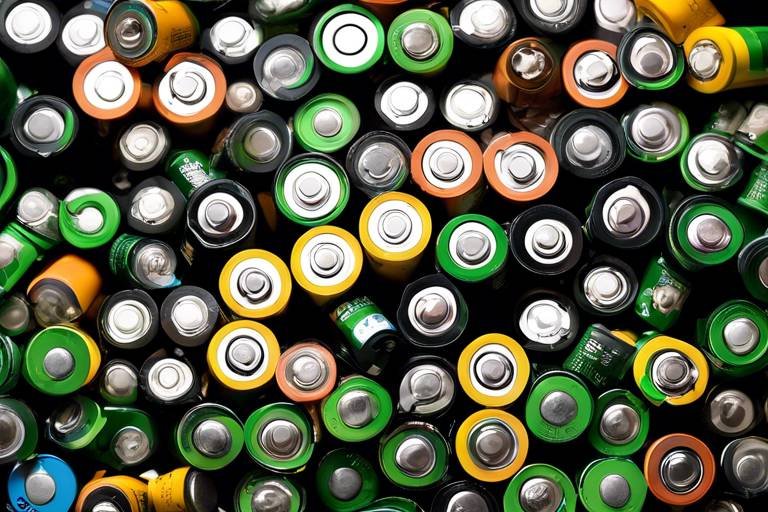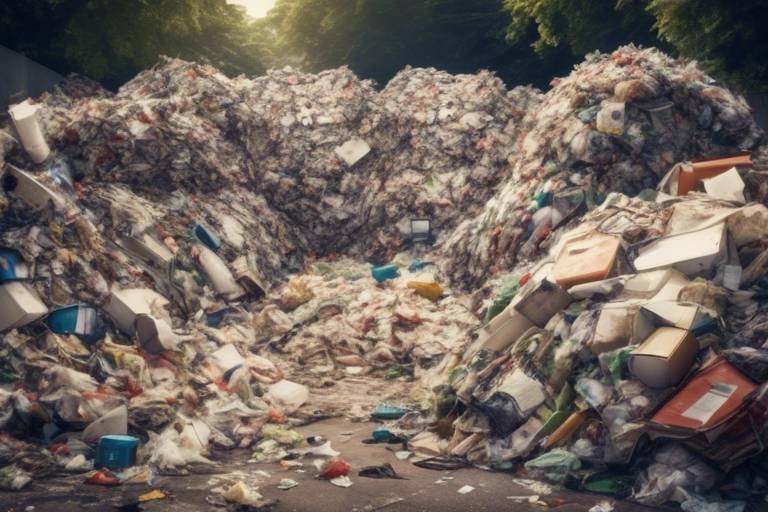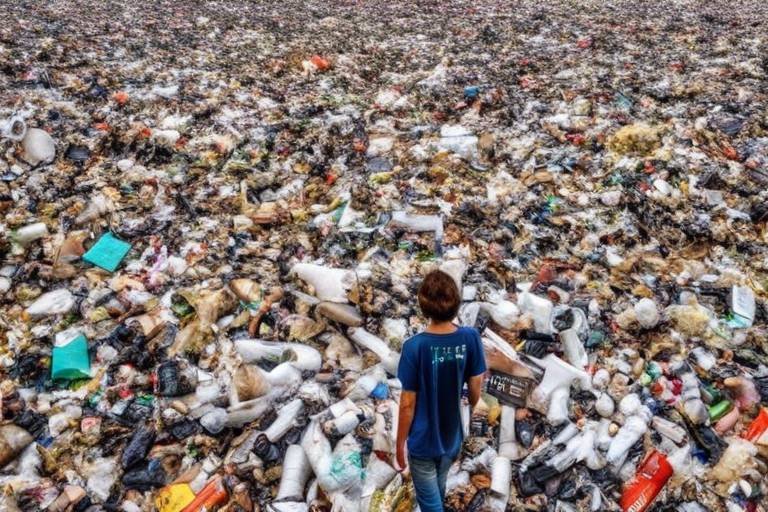What Happens to Your Plastic Bottles After You Recycle Them
Have you ever wondered what really happens to your plastic bottles after you toss them into the recycling bin? It's a journey that many of us are blissfully unaware of, yet it holds significant implications for our environment and our consumer habits. When you think about it, recycling is like sending your plastic bottles on a grand adventure, transforming them from waste into valuable resources. But this journey is not as straightforward as it seems; it’s filled with processes, challenges, and a lot of hard work that goes unnoticed. In this article, we'll dive deep into the recycling process, explore the different types of plastic bottles, and understand the importance of proper recycling practices. By the end, you'll not only appreciate the effort that goes into recycling but also recognize your role in this vital process.
Understanding how plastic bottles are collected, sorted, and processed is crucial. The journey begins at your curbside, where waste management services pick up your recyclables. But what happens next? First, your bottles are taken to a recycling facility where they undergo a meticulous sorting process. This is where the magic happens! The bottles are sorted by type and color, ensuring that only the right materials are processed together. This is vital because mixing different plastics can contaminate the recycling stream, making it harder to produce high-quality recycled materials.
Once sorted, the bottles are cleaned to remove any labels, caps, or residues that could interfere with the recycling process. This cleaning stage is akin to giving your bottles a refreshing bath before they embark on their new life. After that, they are shredded into small flakes, which are then melted down and formed into pellets. These pellets are the building blocks for new products, ready to be transformed into everything from new bottles to clothing and even furniture!
Not all plastic bottles are created equal. Understanding the different types of plastics used in bottles is essential for effective recycling. Most plastic bottles fall into one of several categories, each identified by a recycling code that ranges from 1 to 7. For instance, polyethylene terephthalate (PETE), marked with a 1, is commonly used for water and soda bottles. High-density polyethylene (HDPE), marked with a 2, is often found in milk jugs and detergent bottles. Knowing these codes can help consumers make informed choices about recycling.
| Recycling Code | Type of Plastic | Common Uses |
|---|---|---|
| 1 | Polyethylene Terephthalate (PETE) | Water bottles, soda bottles |
| 2 | High-Density Polyethylene (HDPE) | Milk jugs, detergent bottles |
| 3 | Polyvinyl Chloride (PVC) | Plumbing pipes, shrink wrap |
| 4 | Low-Density Polyethylene (LDPE) | Grocery bags, bread bags |
| 5 | Polypropylene (PP) | Yogurt containers, straws |
| 6 | Polystyrene (PS) | Disposable coffee cups, plastic food boxes |
| 7 | Other | Multi-layered plastics, various other types |
Sorting plastic bottles accurately is essential for effective recycling. When different types of plastics are mixed together, it can lead to contamination, which ultimately reduces the quality of the recycled material. This is where advanced technologies come into play. Recycling facilities use a combination of manual labor and automated systems to ensure that plastics are sorted correctly.
Manual sorting methods rely on human workers to identify and separate different types of plastics. While this approach can be effective, it is also time-consuming and prone to errors. On the other hand, automated sorting systems use advanced technology, such as infrared sensors and air jets, to identify and separate plastics quickly and accurately. Each method has its advantages and disadvantages, but the goal remains the same: to ensure that only clean, sorted plastics make it to the recycling stage.
Contaminants can derail the recycling process. Common materials that can contaminate plastic bottles include food residues, non-recyclable plastics, and even caps and labels. These contaminants can compromise the quality of recycled plastic, making it less valuable and harder to process. Therefore, it’s crucial for consumers to rinse their bottles and remove any non-recyclable components before placing them in the recycling bin.
Despite advancements, recycling plastic bottles faces numerous challenges. Economic barriers, such as fluctuating market prices for recycled materials, can make recycling less appealing for businesses. Logistically, the collection and transportation of recyclables can be inefficient, leading to increased costs and environmental impact. Additionally, technological barriers hinder the development of more effective recycling methods. Overcoming these challenges requires collaboration among consumers, businesses, and policymakers.
Recycled plastic has a variety of applications. Once processed, the pellets made from recycled bottles can be used to create a wide range of products. From textiles and clothing to containers and construction materials, the possibilities are endless. For instance, did you know that recycled plastic can be turned into insulation for jackets or even used in the production of outdoor furniture? This not only reduces waste but also conserves valuable resources.
Recycling plastic bottles offers significant environmental benefits. By recycling, we reduce the amount of waste sent to landfills, conserve natural resources, and lower greenhouse gas emissions. Each bottle recycled contributes to a more sustainable future, helping to protect our planet for generations to come. It’s a simple action that can lead to profound impacts!
Consumers play a vital role in the recycling process. It’s essential to understand the importance of proper disposal and recycling practices. By educating ourselves and others, we can encourage better recycling habits and contribute to a healthier planet. Remember, every small action counts! So next time you finish a bottle, think about its journey and how you can make a difference.
- What types of plastic can be recycled? Most plastic bottles marked with recycling codes 1 and 2 are widely accepted in recycling programs.
- How can I prepare my plastic bottles for recycling? Rinse out any food or drink residues, remove caps and labels, and flatten the bottles if possible.
- What happens if I don't recycle properly? Improper recycling can lead to contamination, which may cause entire batches of recyclables to be sent to landfills.
- Can recycled plastic be used to make new bottles? Yes, many companies use recycled plastic to create new bottles and other products.

The Recycling Process
Understanding how plastic bottles are collected, sorted, and processed is crucial for anyone interested in making a positive impact on the environment. The journey of a plastic bottle begins at your curbside, where it is picked up during regular waste collection. But what happens next? This is where the magic of recycling comes into play, transforming discarded bottles into valuable resources. The process can be broken down into several key steps:
- Collection: Plastic bottles are gathered from homes, businesses, and recycling bins. This initial step is vital as it sets the stage for the entire recycling process.
- Transportation: Once collected, the bottles are transported to a recycling facility. This journey can vary in length depending on the location of the facility.
- Sorting: At the facility, bottles are sorted into different categories based on their type and color. This is a critical step because not all plastics can be recycled together.
- Cleaning: After sorting, the bottles undergo a thorough cleaning process to remove any contaminants such as labels, dirt, or leftover liquids.
- Processing: Finally, the clean bottles are shredded into small pieces, melted down, and formed into pellets that can be used to create new products.
Each of these steps plays a significant role in ensuring that the recycling process is efficient and effective. However, it’s essential to recognize that the journey doesn't end here. The success of recycling largely depends on how well consumers practice proper recycling habits. For example, rinsing out bottles before placing them in recycling bins can significantly enhance the cleaning process, making it easier for facilities to handle the materials.
Moreover, the recycling process is not without its challenges. Contaminants, such as food residues or non-recyclable materials, can severely disrupt the efficiency of recycling operations. This is why public awareness and education about recycling practices are so important. By understanding the recycling process and the role each individual plays, we can collectively improve the system and reduce waste.
In summary, the recycling process is a complex but essential journey that transforms plastic bottles from waste into valuable materials. By engaging in proper recycling practices and understanding the steps involved, we can contribute to a more sustainable future for our planet.

When it comes to plastic bottles, not all are created equal! Understanding the different types of plastics used in bottles is essential for effective recycling. Each type of plastic has unique properties, which influence how they are processed and ultimately reused. Most plastic bottles are made from one of the following materials: Polyethylene Terephthalate (PET), High-Density Polyethylene (HDPE), and Polypropylene (PP). These materials are identified by their recycling codes, which are typically found on the bottom of the bottles. Let’s take a closer look at these common types:
| Plastic Type | Recycling Code | Common Uses |
|---|---|---|
| Polyethylene Terephthalate (PET) | 1 | Soft drink and water bottles, food containers |
| High-Density Polyethylene (HDPE) | 2 | Milk jugs, detergent bottles, juice bottles |
| Polypropylene (PP) | 5 | Yogurt containers, straws, bottle caps |
Each type of plastic has its own recycling processes and challenges. For instance, PET is widely accepted in recycling programs and can be transformed into new bottles, clothing, and even carpeting. On the other hand, HDPE is known for its strength and resistance to impact, making it popular for containers that require durability. Meanwhile, PP is less commonly recycled, which can lead to a higher rate of waste if not managed properly.
It's also important to note that the recycling process can be significantly affected by the type of plastic being recycled. Not all facilities are equipped to handle every type of plastic, and this can lead to a situation where recyclable materials end up in landfills instead of being processed correctly. Therefore, understanding these types can help consumers make more informed decisions about their recycling habits.
Moreover, the presence of recycling codes not only helps identify the type of plastic but also informs consumers about the recyclability of the product. By looking for these codes, you can easily determine whether the plastic bottle you are using is suitable for recycling in your area. This knowledge empowers consumers to make choices that are more environmentally friendly and encourages better recycling practices.
In conclusion, recognizing the different types of plastic bottles and their respective recycling codes is vital for effective recycling efforts. By being informed, you can play a significant role in reducing plastic waste and contributing to a more sustainable future.
- What are the most commonly recycled plastic bottles? The most commonly recycled plastic bottles are those made from PET and HDPE.
- How can I tell if my plastic bottle is recyclable? Look for the recycling code on the bottom of the bottle; if it is 1 (PET) or 2 (HDPE), it is usually recyclable.
- What happens if I put a non-recyclable plastic bottle in the recycling bin? Non-recyclable plastics can contaminate the recycling stream, making it harder to process other recyclable materials.

When it comes to recycling plastic bottles, sorting might just be the unsung hero of the entire process. Imagine trying to bake a cake without separating the flour from the sugar; it just wouldn't work out, right? Similarly, sorting plastic bottles is crucial for ensuring that the recycling process runs smoothly and efficiently. Proper sorting allows for the separation of different types of plastics, which is essential because not all plastics can be recycled together. In fact, mixing them can lead to contamination, which can compromise the quality of the recycled materials.
Each type of plastic has its own unique properties and recycling requirements. For instance, the recycling codes on bottles—ranging from 1 to 7—indicate the type of plastic used, such as PETE or HDPE. These codes help recycling facilities determine how to process the materials effectively. Without proper sorting, you risk creating a mishmash of plastics that can lead to lower-quality recycled products. In essence, sorting is like laying a strong foundation for a house; without it, everything else is at risk of collapsing.
Technological advancements have made sorting more efficient, but human intervention remains vital. Many recycling facilities employ a combination of manual and automated sorting methods. Automated systems use technologies like infrared sensors and air jets to identify and separate plastics quickly. However, these systems can sometimes struggle with contaminants—materials that shouldn't be in the recycling stream, like food residue or non-recyclable items. This is where human sorters come in, providing a crucial layer of oversight to catch what machines might miss.
Moreover, the importance of sorting extends beyond just efficiency; it significantly impacts the environment. When plastics are sorted correctly, more materials can be recycled, leading to less waste in landfills and a reduction in the demand for virgin plastic production. This not only conserves natural resources but also lowers greenhouse gas emissions associated with plastic manufacturing. So, the next time you toss that empty bottle into the recycling bin, remember that its journey to becoming a new product starts with your commitment to proper sorting.
In summary, sorting is not just a preliminary step in the recycling process; it is a vital component that influences the entire lifecycle of plastic bottles. By understanding its significance, we can all contribute to a more sustainable future. So, let’s make sorting a priority and play our part in this crucial environmental effort!
- Why is sorting plastic bottles important? Sorting ensures that different types of plastics are processed correctly, which improves recycling efficiency and product quality.
- What happens if I don’t sort my recyclables? Failure to sort can lead to contamination, which can ruin entire batches of recyclable materials and reduce the effectiveness of recycling efforts.
- How can I improve my recycling habits? Always check the recycling codes on your plastic bottles and ensure they are clean and free from food residue before placing them in the recycling bin.

When it comes to recycling plastic bottles, sorting is a critical step that can make or break the entire process. Think of sorting as the first line of defense in a recycling facility. On one side, we have manual sorting, where workers meticulously inspect and separate materials by hand. This method allows for a more detailed examination of each item, ensuring that contaminants are caught before they can interfere with the recycling stream. However, while manual sorting can be precise, it is also time-consuming and labor-intensive. Imagine a team of dedicated individuals working tirelessly, day in and day out, to ensure that every bottle is placed in the right category. Their efforts are commendable, but the sheer volume of materials can be overwhelming.
On the other hand, we have automated sorting systems, which use advanced technology to identify and separate plastics based on various characteristics, such as size, shape, and density. These systems often utilize conveyor belts, sensors, and artificial intelligence to efficiently process large quantities of bottles in a fraction of the time it would take a human worker. For example, an automated sorting system can sort thousands of bottles per hour, significantly increasing the throughput of recycling facilities. However, while automation boosts efficiency, it may lack the nuanced understanding that a human eye can provide. Contaminants that are not easily identifiable by machines might slip through the cracks, leading to potential issues down the line.
To give you a clearer picture of the differences, here's a quick comparison:
| Aspect | Manual Sorting | Automated Sorting |
|---|---|---|
| Speed | Slower, as it relies on human labor | Faster, capable of processing large volumes quickly |
| Accuracy | High accuracy, can catch subtle contaminants | Variable accuracy, may miss certain contaminants |
| Cost | Higher labor costs | Higher initial investment but lower long-term costs |
| Flexibility | Can adapt to changes in material types | Less flexible, dependent on programmed parameters |
In conclusion, both manual and automated sorting methods have their unique advantages and challenges. The ideal recycling facility often employs a combination of both approaches to maximize efficiency while maintaining high standards of quality. As we strive for a more sustainable future, understanding these sorting methods can help us appreciate the complexities involved in recycling plastic bottles and the importance of ensuring that we do our part by properly sorting our recyclables at home.
- What is the main difference between manual and automated sorting? Manual sorting relies on human labor for accuracy, while automated sorting uses technology to process materials quickly.
- Can automated sorting catch all contaminants? No, while automated systems are efficient, they may miss certain contaminants that a human eye would catch.
- Which sorting method is more cost-effective? Automated sorting may have higher initial costs but can lead to lower long-term operational costs.

When it comes to recycling plastic bottles, one of the most significant hurdles is the issue of contamination. Contaminants can severely disrupt the recycling process, leading to increased costs and reduced efficiency. But what exactly do we mean by contaminants? In simple terms, these are materials that shouldn't be mixed with recyclable plastics. They can range from food residues to non-recyclable items. For example, a plastic bottle that still has a bit of soda left in it can wreak havoc in the recycling stream.
Identifying and removing contaminants is crucial for maintaining the quality of recycled materials. When plastic bottles are contaminated, they often end up in the landfill instead of being recycled. This not only defeats the purpose of recycling but also contributes to the growing waste crisis. Here are some of the most common contaminants that recyclers encounter:
- Food Residues: Leftover liquids or solids can lead to unpleasant odors and attract pests.
- Non-Recyclable Plastics: Items like plastic bags or food wrappers can mix with bottles, complicating the recycling process.
- Labels and Adhesives: Many labels are made from different types of plastic or paper, which can interfere with the recycling of the bottle itself.
- Caps and Lids: Often made from a different type of plastic, these can cause issues if not sorted properly.
Understanding these contaminants is vital for anyone looking to improve their recycling habits. By ensuring that bottles are clean and free of foreign materials, consumers can play a pivotal role in enhancing the efficiency of recycling programs. It’s a bit like cooking; if you mix the wrong ingredients, the dish might not turn out as expected. Similarly, mixing contaminated materials with recyclable plastics can spoil the entire batch.
Moreover, recycling facilities are equipped with advanced technologies to detect and remove these contaminants, but the process can be costly. Manual sorting still plays a role, but relying solely on human labor is not feasible for large-scale operations. This is where automation comes into play, using sensors and AI to identify and separate contaminants. However, even the best technology can only do so much if the initial input is heavily contaminated.
In conclusion, keeping plastic bottles free from common contaminants is essential for a successful recycling process. By being mindful of what goes into the recycling bin, consumers can help ensure that more plastic bottles are recycled effectively, contributing to a cleaner and more sustainable environment.
Q1: What should I do if my plastic bottle has food residue?
A1: Rinse the bottle out before recycling it. A quick rinse is usually sufficient to remove any leftover food or drink.
Q2: Are all plastic bottle caps recyclable?
A2: It depends on the recycling program in your area. Some facilities accept caps, while others do not. Check your local guidelines.
Q3: How can I minimize contamination in my recycling?
A3: Always clean your recyclables and separate materials according to your local recycling rules. Avoid placing non-recyclable items in the recycling bin.

Despite the increasing awareness and efforts surrounding recycling, the journey of plastic bottles from your recycling bin to their next life is fraught with challenges. One of the most significant hurdles is economic viability. Recycling plastic can be costly, and often, the price of new plastic is cheaper than that of recycled materials. This creates a disincentive for companies to invest in recycling infrastructure. Imagine trying to sell lemonade at a price higher than your competitors; you'd struggle to attract customers. In the same way, recycled plastics often have a hard time competing with virgin materials.
Logistical issues also play a critical role in the recycling process. Collecting, sorting, and transporting plastic bottles requires a well-coordinated system. Unfortunately, many areas lack the necessary facilities or funding to support effective recycling programs. This can lead to bottlenecks where recyclable materials are not processed efficiently. For instance, if a community has limited access to recycling centers, many bottles end up in landfills instead. It's like having a great recipe but missing half the ingredients; you can’t make the dish as intended.
Furthermore, technological barriers exist. Not all recycling facilities are equipped with the latest technology to handle various types of plastics. This can result in a lower quality of recycled material, making it less desirable for manufacturers. For example, if a facility can only sort certain types of plastics, those that are not sorted correctly may end up in the waste stream. In this context, the importance of advanced sorting technologies cannot be overstated. They can significantly improve the efficiency of recycling processes, but the cost of implementing such technologies can be prohibitive for many facilities.
Finally, consumer behavior plays a pivotal role in the recycling challenges. Many consumers are unaware of how to properly recycle their plastic bottles, leading to contamination and inefficiency. For example, if people don’t rinse out their bottles before recycling, leftover liquids can contaminate entire batches of recyclables. This is akin to trying to bake a cake with spoiled ingredients; the end result is bound to be disappointing. Educating consumers about proper recycling practices is essential to overcoming these challenges.
In summary, the recycling of plastic bottles faces numerous challenges, including economic viability, logistical issues, technological barriers, and consumer behavior. Addressing these problems requires a concerted effort from all stakeholders, including governments, businesses, and consumers. Only by working together can we hope to create a more sustainable future for our planet.

When you toss your plastic bottles into the recycling bin, you might not realize the incredible journey they embark on. After being processed, these recycled plastics are transformed into a myriad of useful products that play a significant role in our daily lives. It's fascinating to think that your old beverage container could become something as essential as a t-shirt or even a part of a car! The versatility of recycled plastic is astounding, and understanding its uses can help us appreciate the recycling process even more.
One of the most common applications for recycled plastic is in the production of textiles. Brands are increasingly turning to recycled plastic bottles to create fabrics for clothing, carpets, and even upholstery. For instance, did you know that a single recycled plastic bottle can be transformed into enough fabric to make a t-shirt? This not only reduces waste but also lessens the demand for virgin materials, which is a win-win for the environment.
In addition to textiles, recycled plastic finds its way into various containers and packaging. Many food and beverage companies are now opting for bottles made from recycled materials, which helps close the loop in the plastic lifecycle. This shift not only conserves resources but also sends a strong message to consumers about the importance of sustainability. Imagine walking into a store and seeing a shelf lined with products that are not just eco-friendly but also made from materials that were once discarded!
Moreover, recycled plastic is used in the construction industry. From insulation materials to plastic lumber for decking, the building sector is embracing recycled plastic as a sustainable alternative. This not only enhances the durability of structures but also contributes to reducing the overall carbon footprint of construction projects. It’s like giving a second life to materials that would otherwise end up in a landfill, and this practice is gaining momentum as more builders recognize its advantages.
To illustrate the diverse applications of recycled plastic, here’s a quick overview of some common products made from recycled bottles:
| Product Type | Description |
|---|---|
| Textiles | Fabrics for clothing, carpets, and upholstery. |
| Containers | Bottles and packaging for food and beverages. |
| Construction Materials | Insulation, plastic lumber, and other building supplies. |
| Consumer Goods | Items like toys, furniture, and storage bins. |
As we continue to innovate and find new uses for recycled plastic, it’s clear that the potential is limitless. By choosing products made from recycled materials, consumers can play a vital role in supporting this sustainable practice. It’s not just about recycling; it’s about making conscious choices that contribute to a healthier planet.
- What types of products can be made from recycled plastic? Recycled plastic can be transformed into textiles, containers, construction materials, and various consumer goods.
- How does recycling plastic help the environment? Recycling reduces waste, conserves resources, and lowers greenhouse gas emissions, contributing to a more sustainable future.
- Can I recycle any plastic bottle? Not all plastic bottles are recyclable. It's important to check the recycling codes and local guidelines.
- What happens if I don’t sort my recyclables correctly? Contaminants can derail the recycling process, making it less efficient and sometimes leading to entire batches being discarded.

Recycling plastic bottles isn't just a trendy thing to do—it's a game changer for our planet! When we recycle, we’re not just keeping our streets clean and our landfills less crowded; we’re actively participating in a larger movement toward sustainability. Imagine a world where resources are conserved, pollution is reduced, and our environment flourishes. Sounds like a dream, right? Well, recycling is one of the keys to making that dream a reality!
One of the most significant environmental benefits of recycling plastic bottles is the reduction of waste that ends up in landfills. According to recent statistics, recycling one ton of plastic can save around 7.4 cubic yards of landfill space. That's like clearing out an entire room just by recycling! When we recycle, we give plastic a second life, transforming it into new products instead of letting it languish in a dump for hundreds of years.
Moreover, recycling conserves precious natural resources. For instance, producing new plastic from recycled materials uses significantly less energy and raw materials compared to manufacturing it from scratch. The Energy Department estimates that recycling plastic saves about 66% of the energy required to produce new plastic. This means fewer fossil fuels are consumed, leading to a decrease in greenhouse gas emissions. Just think about it: every bottle you recycle contributes to a reduction in carbon footprint, helping to combat climate change!
Additionally, recycling plastic bottles aids in lowering pollution levels. When plastic waste is burned, it releases toxic chemicals into the air, contributing to air pollution. Recycling helps mitigate this issue by keeping plastic out of incinerators and landfills. As a result, we can breathe a little easier knowing that we are reducing harmful emissions and protecting our health and the environment.
Now, let’s not forget about the economic benefits! A thriving recycling industry creates jobs and stimulates local economies. In fact, the recycling sector employs over 1.1 million people in the United States alone. By recycling, we’re not just helping the environment; we’re also boosting our economy and creating opportunities for growth.
In summary, the environmental benefits of recycling plastic bottles are vast and impactful. From conserving resources and reducing pollution to creating jobs and saving energy, the act of recycling is a powerful tool in our fight for a sustainable future. So, the next time you toss a plastic bottle into the recycling bin, remember that you’re not just disposing of waste; you’re playing a crucial role in protecting our planet!
- What types of plastic bottles can be recycled? Most plastic bottles marked with recycling codes #1 (PET) and #2 (HDPE) are widely accepted in recycling programs.
- How can I ensure my plastic bottles are recycled properly? Rinse out your bottles and remove any caps or labels before placing them in the recycling bin.
- What happens if I don't recycle my plastic bottles? If not recycled, plastic bottles can take hundreds of years to decompose, contributing to pollution and landfill overflow.
- Can I recycle plastic bottles with food residue? No, food residue can contaminate the recycling process, so it's important to clean them before recycling.
- What are some products made from recycled plastic? Recycled plastic can be transformed into various products, including clothing, furniture, and new plastic containers.

When it comes to recycling plastic bottles, consumers hold the key to a sustainable future. Each time you toss a bottle into the recycling bin, you're not just discarding waste; you're making a conscious decision that can ripple through the entire recycling process. But how can you ensure that your actions contribute positively to the environment? It starts with understanding the importance of proper disposal and recycling practices.
One of the first steps in being a responsible consumer is to familiarize yourself with your local recycling guidelines. Did you know that recycling rules can vary significantly from one municipality to another? Some areas accept all types of plastics, while others may only recycle specific ones. This discrepancy can lead to confusion, which is why it's essential to check with your local waste management authority. You can often find this information on their website or through community resources.
Additionally, cleanliness matters when it comes to recycling. Before tossing your plastic bottles into the recycling bin, make sure to rinse them out. Residual liquids and food particles can contaminate the entire batch of recyclables, making it more challenging for recycling facilities to process them effectively. In fact, contamination is one of the most common issues that hamper recycling efforts. To put it into perspective, a single dirty bottle can spoil an entire truckload of recyclable materials!
Moreover, it's crucial to be aware of how you dispose of other materials alongside your plastic bottles. Many people unknowingly mix non-recyclable items with recyclables, which can lead to significant problems down the line. For instance, items like plastic bags, food containers, and polystyrene foam are often not accepted in curbside recycling programs. Understanding what can and cannot be recycled is vital for making a meaningful impact.
Another aspect of consumer responsibility is advocating for better recycling practices in your community. Engage with local policymakers and support initiatives that aim to improve recycling infrastructure. Whether it's through community clean-up days, educational workshops, or simply spreading the word about recycling best practices, every little effort counts. You can also encourage businesses to adopt sustainable practices by choosing to support companies that prioritize recycling and sustainability.
Ultimately, being a responsible consumer is about making informed choices. By understanding the recycling process and the importance of your role within it, you can help create a cleaner, healthier planet. Remember, every small action contributes to a larger movement towards sustainability. So, the next time you reach for that plastic bottle, think about the journey it will take and how your choices can make a difference.
- What types of plastic bottles can I recycle? Most curbside recycling programs accept PETE (1) and HDPE (2) bottles. Always check local guidelines for specifics.
- Do I need to clean my bottles before recycling? Yes, rinsing out bottles helps prevent contamination and improves recycling efficiency.
- Can I recycle plastic caps? It depends on local regulations. Some facilities accept caps, while others do not. Check your local guidelines.
- What happens if I put the wrong items in the recycling bin? Contaminated recyclables can be sent to landfills instead of being recycled, which defeats the purpose of recycling.
Frequently Asked Questions
- What happens to my plastic bottles after I recycle them?
When you recycle plastic bottles, they go through a series of steps that start with collection and sorting. After being picked up from your curbside, they are taken to a recycling facility where they're sorted by type and cleaned. This ensures that only the right materials are processed, ultimately transforming them into new products.
- Why is sorting plastic bottles important?
Sorting is crucial because different types of plastics have different properties and recycling processes. If plastics are mixed, it can lead to contamination, making recycling less efficient. Proper sorting ensures that each type of plastic is recycled in the way it was designed to be, maximizing the quality and usability of the recycled material.
- What types of plastic bottles can be recycled?
Most commonly, plastic bottles made from PET (Polyethylene Terephthalate) and HDPE (High-Density Polyethylene) can be recycled. These plastics are usually labeled with recycling codes 1 and 2. However, other types, like PVC or polystyrene, are not as easily recyclable and can cause problems in the recycling process.
- What are common contaminants in plastic recycling?
Common contaminants include food residues, labels, and other materials that are not plastic. These contaminants can hinder the recycling process by causing batch contamination, which can result in lower quality recycled products or even entire batches being sent to landfills.
- What challenges does plastic recycling face?
Plastic recycling faces several challenges, including economic hurdles, logistical issues, and technological limitations. For instance, the fluctuating market for recycled materials can make it less profitable for companies to recycle. Additionally, the complexity of sorting and processing various plastics can complicate the recycling efforts.
- What products are made from recycled plastic bottles?
Recycled plastic bottles can be transformed into a wide range of products, such as clothing, carpets, insulation for homes, and even new containers. The versatility of recycled plastic helps reduce waste and conserve resources, showing just how valuable recycling can be!
- How does recycling plastic benefit the environment?
Recycling plastic bottles significantly benefits the environment by reducing the amount of waste sent to landfills, conserving natural resources, and lowering greenhouse gas emissions. By recycling, we can help create a more sustainable future and lessen our impact on the planet.
- What can I do to improve my recycling habits?
You can improve your recycling habits by ensuring that you properly clean and sort your plastic bottles before recycling them. Familiarize yourself with your local recycling guidelines, and consider reducing your plastic usage overall. Every little effort counts towards making a healthier planet!

